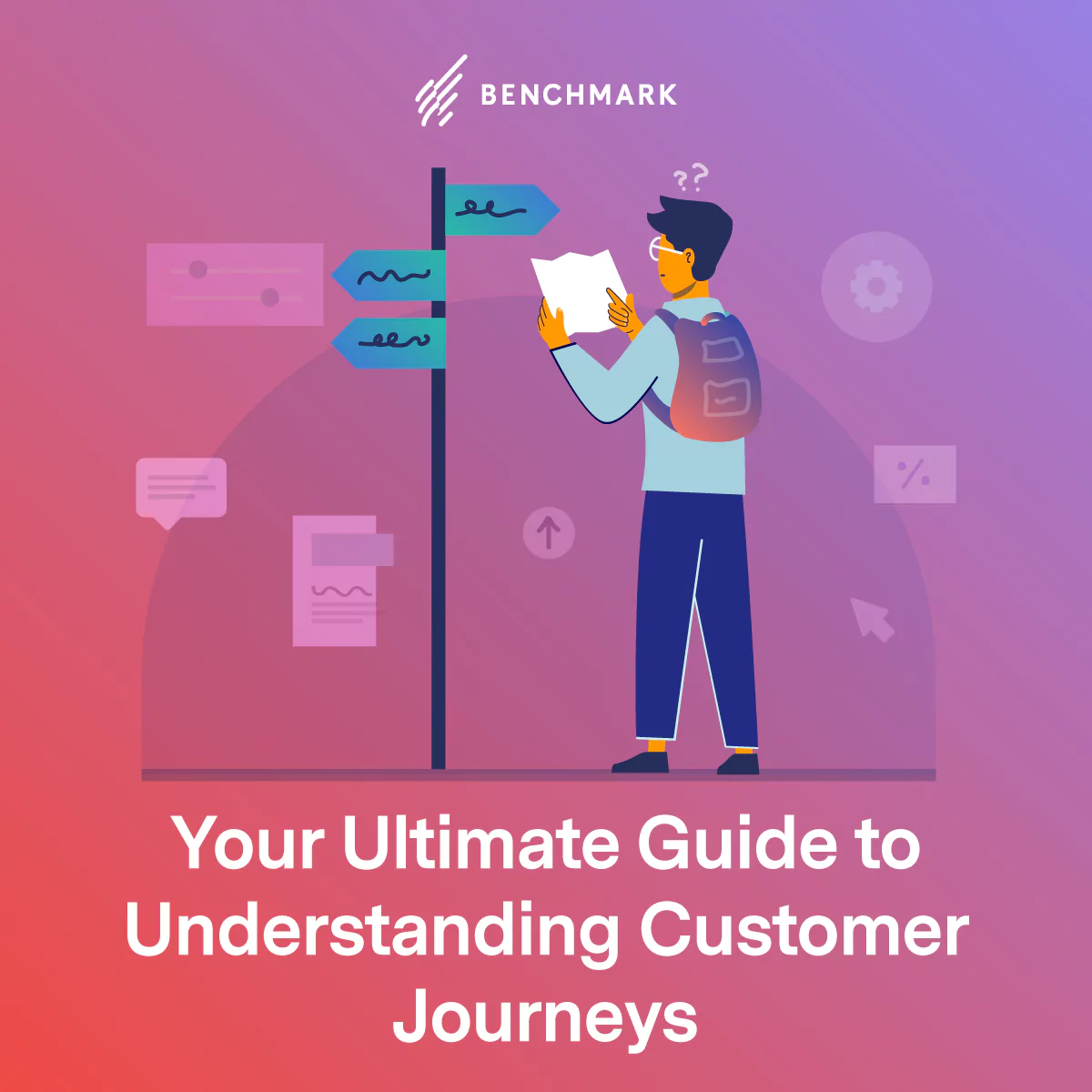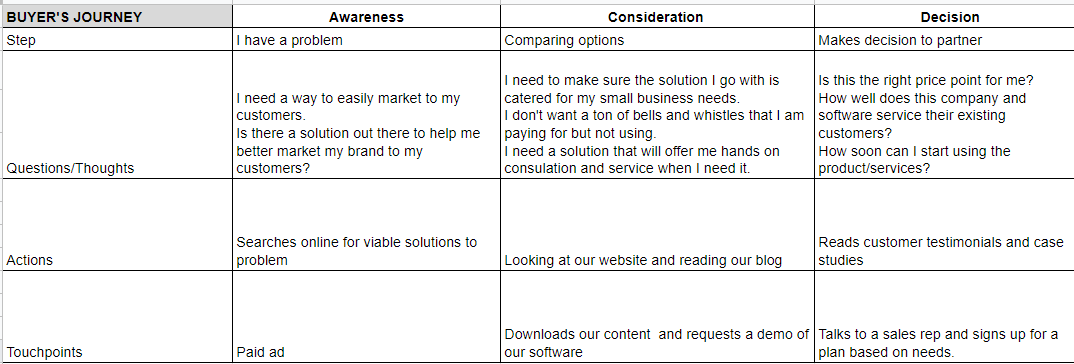
“Journey” is a pretty popular word nowadays. We hear it used to describe a spiritual path someone’s taking or a sudden wellness obsession. But for marketers, understanding the journey our customers are on is more concrete. It’s about identifying the actual steps customers take when interacting with our brand.
Our customers’ motivations, their understanding of what it is we do, and why it matters to them are at the core of all our efforts. So it’s absolutely imperative that we know what their journey looks like, especially if we’re wanting to influence it.
Having a map of your customer journeys will give you all the possible action steps your customers can take in relation to your brand. There’s a lot of moving parts and things to consider, so let’s start with digging deeper into why having a customer journey map is important.

The Value of A Customer Journey Map
You can think you know your customers like the back of your hand. But you still need to clearly identify the possible paths they’re taking. Doing so can ensure you’re covering all your bases and help uncover some unknowns that you may not be aware of. Not only that, it can help create a better customer experience, which we all know leads to a more harmonious partnership.
Here are a few benefits of mapping out your customer journey.
1. You’ll Strengthen Your Content Marketing
Inbound marketing is a more passive approach to selling your company. Instead of going after your next client, which is an outbound tactic, you’re bringing your customers to you. You’re putting your customers in the driver’s seat, so-to-speak.
But how do you do that? Most modern consumers are doing their own research online before making a buying decision. So, when you create content, you’re creating that research material for your consumers to find and look into. You’re helping them make their buying decisions. But in order to create the right content, you need to know their behavior and what they are engaging with the most. Mapping their customer journey will help you improve your content marketing strategy so that the content you create is not only valuable to you but valuable to your customers.
2. You’ll Reduce Costs by Focusing on Inbound Marketing
Outbound marketing isn’t the most cost-effective approach to selling. You have additional salaries to account for, as well as the added fees of sending them to conferences and events to garner more attention for your business. They also need swag, collateral, and other sales materials that assist them in their in-person meetings.
What’s more, outbound tactics are simply not as effective as they used to be. Only 18 percent of marketers believe outbound practices yield the highest quality leads. If the sales tactic you’re using isn’t yielding high-quality leads, then chances are those leads also aren’t converting. And if your outbound leads aren’t becoming customers, then you’re just wasting money on outbound efforts.
It doesn’t cost you a dime to nurture your inbound leads. All you have to do is provide them with the content you’re already creating. And by mapping out their journey, you’ll be able to identify the most optimal content to send and the time to send it.
3. Your Entire Company Will Know Your Customers Better
Each department within your company has specific tasks and objectives. It’s easy for each to get siloed, forgetting who’s at the core of your business: the consumer. When you create a customer journey map, your marketing and sales teams are not the only departments that can benefit from it. Knowing the ins and outs of your consumer, what actions they take on your site, what content they’re downloading, and how they’re eventually making their way through the funnel is beneficial for every single person at your company. You can share the map with your entire team, which can help them provide better customer service and understand how certain departments, like sales and marketing, achieve their goals.
So we got it. Mapping your customer journey is important. But how do you actually go about putting one together?
Creating Your Customer Journey Map
Well, there’s a lot of ways you can put one together, and it mostly depends on what works best for your company, goals, and abilities. There are three main kinds of customer journey maps:
- Current State: Focuses on your consumers’ current thoughts, actions, and feelings while interacting with your brand.
- Future State: Focuses on your consumers’ future thoughts, actions, and feelings while interacting with your brand.
- Buyer’s Journey: Focuses on the three main stages of the buyer’s journey – awareness, consideration, decision, and the thoughts, actions, and feelings your consumers have at each stage.
Whichever map you choose to create, you’ll want to make sure you include the entire possible journey, from when your consumers realize they have a problem that needs to be solved to when they figure out the best way to solve it.
Now that we’ve addressed the three main kinds of mapping let’s go through the steps of actually putting yours together.
1. List Your Goals
What are you hoping to achieve by putting together your customer journey map? Are you hoping to figure out where there are holes in your inbound marketing? Are you hoping to find more ideas for content to create? Or, are you trying to reduce the time it takes to move your prospects from the awareness stage to the decision stage? Whatever your goal is, write it down, so you’ll always remember what you’re looking to accomplish.
2. Identify Your Buyer Personas
You probably already have an idea of who your buyers are. List who your ideal client is, and consider the following factors:
- What their job title is
- What industry they’re in
- Who they report to
- What kinds of questions they have
- What their day-to-day looks like
- How they vet partners
You can reach out to your sales team to get a pulse on the people they have conversations with. Or, you can survey your existing clients and ask them specific questions about how they interact with your website and content to help give you a better understanding of who your ideal buyer is. Make sure you focus on one particular customer for your map. This will allow you to get as specific as possible and really understand how your ideal buyer interacts with your brand.
3. Indicate Your Touchpoints
The touchpoints are one of the most important parts, as they’re the instances in which you have the opportunity to connect with your customers. Look into your website analytics first, identifying how your customers are finding you and the touchpoints they’re already taking to interact with you. Some examples:
- Downloading a whitepaper
- Requesting a demo
- Signing up for your email newsletter
- Clicking on a paid ad
- Visiting your site from an off-site mention or piece of content
- Being referred from social media
Make sure you list all the actions possible. If your list is really long, perhaps that means you’re asking your customers to take too many actions. This is the kind of revelation your customer journey map can help you uncover.
4. Know What You Want On Your Map
Okay, now it’s time to start thinking about what fields you actually want to be included on your map. This will depend on the type of map you create. To give you an idea, we’ll focus on the Buyer’s Journey map.
You’ll obviously want to convey the three stages — awareness, consideration, and decision. But, you’ll want to also highlight what steps your consumers are in, what actions they’re taking, their thoughts and questions, and touchpoints.

5. Fill in Any Gaps
Once you identify all these important areas, motivations, thoughts, and actions, you’ll want to ensure you have the appropriate content and resources, and if not, create what you need. Content fuels your email marketing, so it’s important that you have blog content, gated pieces, demo options, pricing information, etc., which will all play an important role in your customer’s journey. It can also be helpful to see if there are any stages your customers are getting caught at or if they’re falling off altogether. That can help you determine if you just aren’t providing them with the resources they need at that particular stage.
6. Make Changes As Needed
Just because your customer journey map looks a certain way now doesn’t mean it will always have to look like that. As your company grows, sometimes so does your software and services. Also, your ideal client may change, and with that comes different motivations and needs. Make sure you regularly look at your customer journey map and compare it against what your current clients and ideal customers look like, as well as what your website analytics and insights tell you.
There you have it, your ultimate guide to understanding customer journeys. Make sure you take some time this quarter to get started on your map so you can better understand your customers and provide them with the resources they need and when they need them. It won’t just service your marketing and sales efforts, but it could help your entire company.



